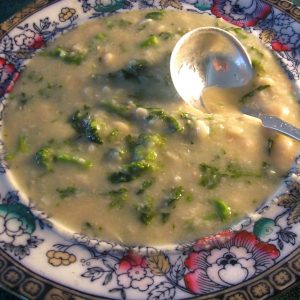In our evolution from apes to humans, somewhere we lost our tails and our tendency to walk on our knuckles. More recently, we lost our cooking gene. Okay, I know — cooking isn’t genetic. It’s a basic life skill, though, one that was passed down as a matter of course from one generation to the next for a few millennia. Then came the explosion of agribusiness and processed food. This only happened within the last half century, but it seems we’ve wiped out most of our collective memory of what it takes to put dinner on the table.
“A whole generation — people in their 40s — did not learn how to cook,” says Kim O’Donnel, author of The Meat Lover’s Meatless Cookbook. “We watch all these cooking shows, but we’ve become a nation of food-obsessed noncooks.”
“I think it sucks,” says New York Times food phenom and less-meatarian guy Mark Bittman.
So do I. Most of my friends don’t cook. They’re otherwise evolved, but they eat out or limp along on processed and prepared food. Maybe you do, too. Because it seems easy.
Processed food isn’t easy — we are. We’re total suckers, falling for marketing ploys and snappy ads. Processed food takes carbon to produce and is loaded with additives, artificial coloring, preservatives, fat, salt, sugar and other things we don’t need. It’s right up there with meat production in terms of the resources it depletes and the health risks it poses. It’s not sustainable, not for you, not for the earth.
In order to evolve, not perish, eat less meat and less processed food. This means doing more in your kitchen than make coffee.
“You eat much better if you cook,” says Bittman, whose new Food Matters Cookbook offers 500 fabulous, do-able less-meatarian recipes. “You are taking control over what you’re eating. The only way to do that is buy the ingredients, eat them raw or cook them. If you’re letting other people cook your food, you are not in control.”
I’m all for outsourcing when it’s called for. I wouldn’t perform brain surgery on myself or anyone who needs it. As much as I’d want to do a great job, I lack the skills. Cooking isn’t brain surgery.
Preparing one home-cooked meal will not solve all the world’s problems, but it will empower you, reduce carbon and restore a core life skill. Cooking puts you in control in the kitchen. It’s cheap. It’s easy. It’s also an act of love, a nice thing in these crazy days. It’s love you show yourself, the people you feed and the ingredients you work with. You can’t lose. All this and you get dinner, too.
Where to start? “Rice and beans. Beans and rice,” says Bittman. “It’s the most important dish in the world. You can tell people if they start complaining about protein, shut up, it has protein. You can make it vegan or not, there’s 20 kinds of beans and hundreds of different grains. It just doesn’t stop. Beans and rice is one of the fundamental dishes of western cuisine.”
Bittman isn’t a professionally trained chef. Neither am I. But we can — and do — cook. Call us evolutionary throwbacks. Even better, be one. We’re not handing out these recipes for our health. We’re doing it for yours. The next stage of evolution begins with you.
Tuscan White Beans and Winter Greens Soup
Dried beans are cheap, high-protein pantry staples. Stock up. Except for quick-cooking lentils and split peas, dried beans need to soak overnight before cooking to be their most tender and digestible. If you want beans tomorrow, soak your beans tonight. To soak beans, rinse them first to rid them of any grit and toss any errant pebbles or odd bits that found their way into the mix. Pour beans into a large bowl and cover with a couple of inches of cold water. Dried beans are happy to expand and soak up water, so check your beans every now and again and top up with more water, if needed. When you're ready to cook the beans, drain them and rinse them well. This rustic white bean soup is stockless and gets its goodness and oomph from the beans' own cooking liquid. Half a dozen sage leaves impart an amazing amount of flavor. It's just the thing for cooler weather, costs two bucks all told and feeds six. And you'll have done it yourself. Beans may be cooked a day ahead, if that reduces your anxiety. Plan your life accordingly.Ingredients
- 1 pound white beans cannelini, great Northern, whatever moves you
- 5 cloves garlic
- 1 bay leaf
- 6 fresh sage leaves
- 1 dried red pepper
- 4 tablespoons olive oil
- 1 small head escarole or kale washed well, blotted dry and chopped fine
- 1 pinch red pepper flakes
- 1 cup or more white wine
- sea salt to taste
Instructions


Cant wait to try this, as soon as the weather cools a bit more here in central texas.
Thanks David — gotta say this soup’s a winner. Please let me know your thoughts when the time’s right to make it and taste it.